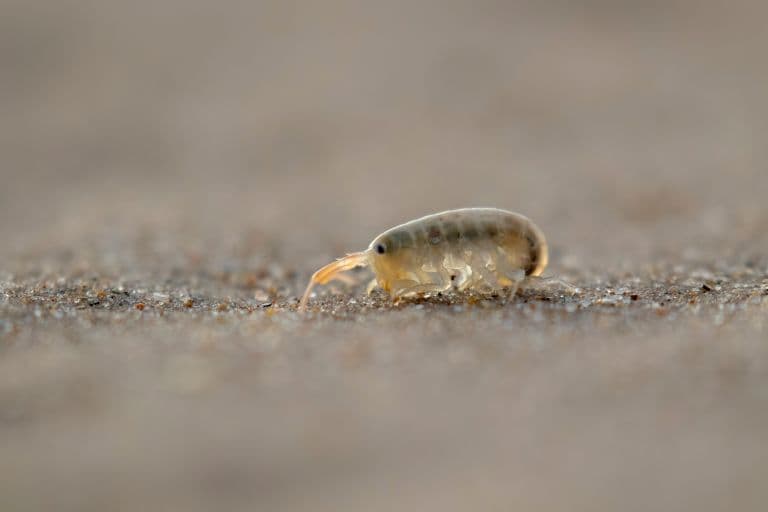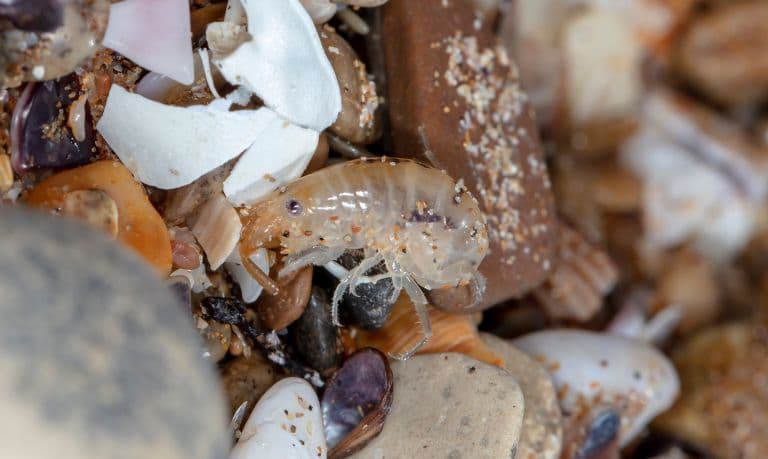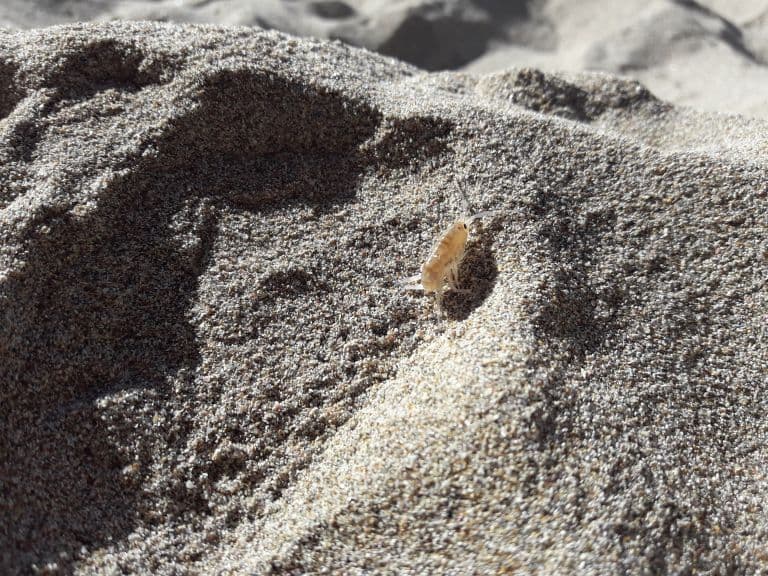Sand Flea Profile
If you’ve ever spent time digging through a smelly shoreline with drying kelp, you might have noticed an abundance of small hopping animals that seem to thrive in decomposition.
These are members of one of the most important orders in the ocean and represent a diverse and cosmopolitan group of crustaceans that provide valuable ecosystem services in both vertical directions in the trophic web.
Sand fleas are oceanic members of the Talitrids, and stand out among other amphipods in their ability to live on land. Each dwellers are often also called ‘sandhoppers’.

Sand Flea Facts Overview
| Habitat: | Tropical and subtropical coastal waters |
| Location: | Tidal waters, beaches |
| Lifespan: | Up to 2 years |
| Size: | Up to 2.5cm (one inch) long |
| Weight: | Not recorded |
| Colour: | Browns, blues, oranges, sometimes reddish |
| Diet: | Algae, plant matter |
| Predators: | Birds, other vertebrates, crabs, |
| Top Speed: | Slow, with a rapid hop |
| No. of Species: | 6,000+ |
| Conservation Status: | Not listed |
Sand fleas are not fleas at all, but they are commonly blamed for the itchy rash that comes from sand flies. And that’s unfair, because, unlike sand flies, they’re doing a lot of work to keep the place tidy.
These small, hopping crustaceans aren’t a threat to anybody, and make up a huge amount of calories for various predators, as well as recycling nutrients from dying algae back into the water systems.
Interesting Sand Flea Facts
1. They’re not fleas
There are a couple of animals commonly known as sand fleas, and the one most commonly given this title is the one that hops about in the detritus on the coast and looks a bit like a large flea. This isn’t technically, a flea.
The other culprit is a flea but doesn’t look or act like one. Tunga penetrans is more commonly known as the jigger flea or chigoa flea, and instead of biting, it burrows kindly into your toes and sets up a little cave under your skin where it swells to enormous sizes and bursts, releasing millions of eggs all over your tweezers.
We won’t be talking about that one today. 1

2. They don’t bite
Despite the wealth of advice on treating and avoiding sand flea bites online, these are likely blaming the wrong animal.
While sand flies are a known pest on beaches, and make up any number of small biting insects in the fly order, sand fleas are not insects, and therefore not fleas.
They’re also not equipped to bite people and are instead small crab-like crustaceans who would rather you leave them alone.
Sand fleas are amphipods, an order of crustaceans that includes tens of thousands of species, across four suborders. These ones are in the suborder Gammaridea, with over 90% of known amphipod species, but the taxonomy on amphipods leaves a lot to be desired (even more than usual) and is in need of a lot of revision.
As amphipods, they use little claws to navigate their world and feed on their algal resources. They’re not interested in human blood and have nothing to bite you with anyway.
3. Sand fleas are easily startled, but they’ll soon be back and in greater numbers
If you’re determined to ignore their preferences, you can find them buried in the shallow sands at the water’s edge. If they’re disturbed, many will hop rapidly to escape (like fleas), run away, or burrow.
And you can find them here in crazy quantities. In Europe, there can be more than 10,000 of these little crustaceans in a single square meter of sand, which, admittedly makes it sound as though they’re two-dimensional, but there’s a lot more to this animal than meets the eye!
Not only are they abundant, but they’re also diverse. This family contains over 6,000 known species, likely a lot more that have yet to be discovered. 2 3
4. They survive where other amphipods can’t
Amphipods are exceptionally abundant in the oceans. They’re found at great depths, in Antarctic waters, and can range in size from a pinhead to a cricket ball.
But they’re generally quite bad at being out of the water. Most species in this order dry up quickly when washed onto shore, but the sand flea is resilient, and this allows it access to niches that have little competition.
Some species are even entirely terrestrial, never needing the ocean at all.
They forage for food at night, spending their days immersed in the wet sand of the coast, where they feed mostly on algal waste like the kelp that washes up on the shore.
5. They’re edible
In Southeast Asia, where anything with a face is fair game, sand fleas are one of the fried snacks you can buy from street food vendors.
The flavour is, unsurprisingly, similar to crab, and they’re cooked in the shell for added crunch. This might seem strange, but it’s an abundant source of healthy nutrition for coastal or island communities such as those in Cambodia and Indonesia and is much more sustainable than most animal products.
But this abundance supports other animals too, and the sheer number of these animals plays a significant role in nutrient recycling at both ends of the trophic ladder.
6. They are integral to the community
Many species will work as beach cleanup crew, nibbling on dead kelp that washes ashore, and keeping the beaches clean.
The waste from this process goes back into the ocean to feed the filter-feeders like mussels and contributes to fertilising the ocean.
At the other end of the process, there are countless birds and other larger animals that will feed on the sand fleas. The majority of fish that cross paths with them will eat them

7. Water pollution is a problem
In both sand flea and freshwater Talitrid communities, water management needs to become a priority if we are to maintain the health of these coastal habitats.
Heavy metal presence affects the abundance of these key organisms, as do changes in climate, so pollution has the potential to affect breeding and foraging success.
While they appear to be insignificant fleas, these are detritus-feeders, and therefore critical to the health and hygiene of the ecosystem. And as such a significant food source, their loss will affect everything around them. 4
Sand Flea Fact-File Summary
Scientific Classification
| Kingdom: | Animalia |
| Phylum: | Arthropoda |
| Class: | Crustacea |
| Order: | Amphipoda |
| Family: | Talitridae |
Fact Sources & References
- Melissa Pino (2023), “Sand Fleas: What Exactly Are They and Do They Bite?”, Planet Natural Research Center.
- “European sand flea”, Britannica.
- BlacktipH (2021), “Catching Jumbo Sand Fleas”, Youtube.
- Raja Jelass (2015), “Biodiversity of Talitridae family (Crustacea, Amphipoda) in some Tunisian coastal lagoons”, Springer Open.
